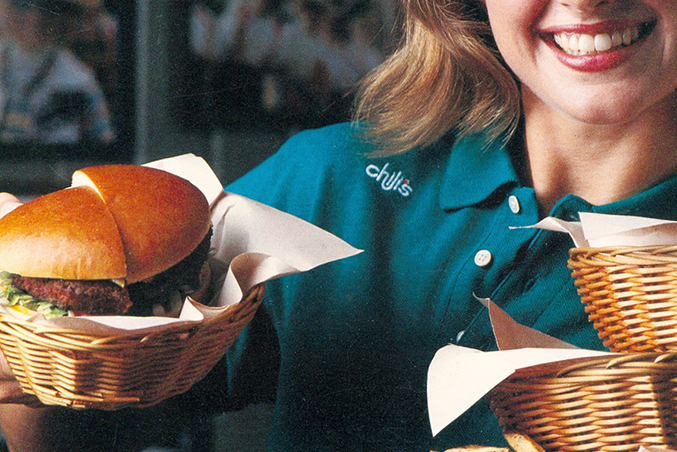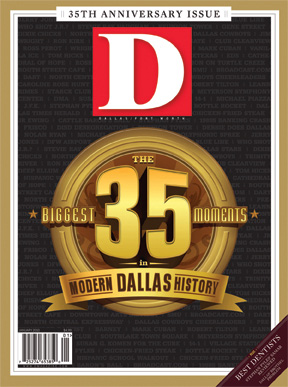On March 13, 1975, Larry Lavine opened his first Chili’s restaurant. The simple concept of a full-service burger joint with Mexican influences became a huge hit and eventually grew into the chain-restaurant juggernaut known as Brinker International. Lavine’s success drew national attention, and the demographics of Dallas drew other restaurateurs to try their luck in Dallas. Thanks to Larry Lavine, “If you can make it in Dallas, you can make it anywhere” became the unofficial slogan of the chain-restaurant business.
The idea for Chili’s was formed somewhere between the Burger House on Hillcrest and Goff’s Hamburgers on Lovers Lane. My parents first took me to Mr. and Mrs. Goff’s Hamburgers when a No. 2 was 25 cents. I rode my Vespa motor scooter to the Burger House and had many a chili cheeseburger and fries.
The time was the early 1970s, and my friend Malloy Buckner and I talked about opening a neighborhood restaurant that served really great burgers and fries. Texas had recently changed the way you could purchase mixed drinks in restaurants and had ended the system of carrying a membership card for every restaurant where you wanted to buy a drink. Our idea was to create a place that was cool enough where you could get a great burger and a margarita at dinner as well as lunch.
A building that Red Coleman owned on Greenville Avenue and Meadow Lane came available. Everyone told us it was too far away from the action on the Greenville strip, but we did not agree. Red gave us a good deal on the rent, and we signed a lease to build our place.
I had been to Carroll Shelby’s chili cook-offs in Terlingua judging chili, and we thought chili would be a good item to add to the menu to have something to talk about to the press.
Another childhood friend, Johnny Fooshee, liked our idea and put a group of fraternity brothers from North Texas State University in a partnership to invest in the restaurant. The total budget for the first one was $75,000, and Johnny raised the money $5,000 at a time. The restaurant cost more than planned, and I sold my car to finish the construction. Tricia Wilson, who later became a world-famous hotel and restaurant designer, helped design the decor, which had booths shaped like shipping crates and a ceiling painted University of Texas orange.
We wanted to have great burgers, a chili dog for variety, and fresh-cut fries. I wanted to serve fries like those at Mac’s Bar-B-Que. Billy McDonald of Mac’s told me how they prepared them, and we tried to duplicate them. Our equipment was bigger than Billy’s, and we kept turning out overcooked fries. I told Billy we would use frozen ones. He said he would come to our place and show us how, which he did. As a result, we were known for great burgers and great fries. If you would like fresh-cut fries like the early days of Chili’s, go to Mac’s on Main Street, near Fair Park.
I was fortunate to assemble a team of bright, dedicated, genuine people to manage the first restaurant. These key players would later build restaurant chains—from Creed Ford with Johnny Carino’s to Doug Brooks, who is CEO of Brinker today, and the late Ken Dennis, who created the award-winning baby back rib jingle for Chili’s.
I learned that if you want to build a brand, you first need a valid concept, and then you must have a great team of people to carry out your vision. Our company philosophy was to make money and have fun. There was a true family spirit in the company, and we all did have a lot of fun.
We opened and did $100 the first day. The word eventually spread that we served great food and had a fun, casual atmosphere with a friendly staff.
The restaurant became popular and soon had a line around the building seven days a week. Every time a review would appear in the paper, our sales would grow, and the line would get longer.
A year later, when we felt we had something that was not a fad, we talked about a second place. We thought the concept of Chili’s was so unique and were so convinced that the Dallas area could support only one that we decided to open our second store in Houston. The second location in Houston was such a big success that we formed Chili’s Inc. (which would later become Brinker International) and opened our third restaurant. The third location was in Dallas, in the Addison area.
My brother, Jack, quit what we called his real job as a CPA and joined the corporation as CFO. Together we used every form of raising money possible to expand the business.
We were going to sell the company to another food company in 1982 when Norman Brinker called and said he would like to help us build the company even bigger. I am one of a very few people who “hired” Norman Brinker. I thought we would not do any worse to not sell at that time. It would be fun to build an even bigger company and maybe go public. It was a privilege to work with Norman. He had the ability to see where things were going and to not let anything stop him from reaching his goal. He mentored many of the leaders of national restaurants today.
People ask me what I think about Chili’s today. I say with more than 1,000 restaurants, it cannot be the same as it was when I left with 50 restaurants open. I do feel somewhere in the operations manuals, SEC filings, and HR procedures structure, there is still a voice that says, “Make money and have fun.”
Larry Lavine is a restaurateur and the owner of Turtle Creek Restaurants.






